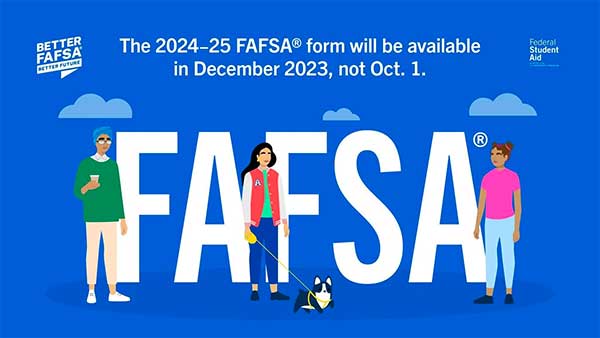Soft launch of the 2024-2025 FAFSA has begun; CSU will receive FAFSA data in March 2024
The Free Application for Federal Student Aid (FAFSA®) form for the 2024-2025 academic year is now available for access during the Federal Student Aid (FSA) "soft" launch. Details regarding the "soft" launch can be found through this link: https://studentaid.gov/announcements-events/fafsa-support. Throughout this initial phase, the FAFSA form may be intermittently accessible as the FSA team closely monitors website performance and form functionality. Scheduled breaks for site maintenance and necessary technical updates have been planned to improve your user experience. If you submit your form during the soft launch, rest assured that your information will be securely saved, eliminating the need for resubmission or reentry of associated details. In case the form is temporarily unavailable during your attempt to access it, we recommend trying again at a later time.
FAFSA Simplification
The FAFSA Simplification Act, passed on December 27, 2020, has brought about significant modifications to the Free Application for Federal Student Aid (FAFSA), slated to be implemented for the 2024-2025 aid year. This overview outlines the key changes and provides preparatory steps to facilitate a seamless application process. Stay tuned for updates to this page as more details emerge.

What does FAFSA Simplification entail?
The FAFSA simplification initiative marks a significant overhaul of the Free Application for Federal Student Aid (FAFSA®) process, representing the first major redesign in more than four decades. The primary objective is to streamline the application process, making it more accessible for students. In the upcoming 2024-2025 FAFSA, the number of questions will be reduced to approximately 37, a substantial decrease from the previous 100 questions.
What are the benefits of FAFSA Simplification?
- An application process that is more streamlined
- Increased eligibility for federal student aid
- Diminished obstacles for specific student groups (such as homeless and unaccompanied youth, incarcerated students, English language learners, and those from low-income backgrounds)
- Improved user experience when completing the FAFSA form
- Strengthened data sharing with the IRS to streamline the applicant's experience
How to Navigate the Changes
Notable adjustments to the application process encompass revisions to the FAFSA form, the application completion process for students and families, and modifications to the eligibility calculation.
The FAFSA form will be expanded to the 11 most common languages spoken by English learner students and their parents. Language-specific resources and support will also be available from FSA Information Center.
The form will be consumer-tested with prospective first-generation students and families, as well as students and families from low-income backgrounds.
The form will include new demographic questions about an applicant’s gender and race/ethnicity.
Rather than importing their tax information using the IRS Data Retrieval Tool, applicants will consent to providing their Federal Tax Information (FTI) via a direct data share with the IRS. This enhanced data sharing simplifies the applicant’s experience.
Eligibility for federal student aid will be expanded in the following ways:
-
- Selective Service and drug conviction questions will be eliminated to reduce applicant barriers.
- New methodology will be introduced to calculate and determine applicant The Expected Family Contribution (EFC) will be replaced with the Student Aid Index (SAI).
- The new need-analysis formula allows for a negative SAI calculation and implements separate eligibility criteria for Federal Pell Grants.
- Federal Pell Grant access will be expanded and linked to family size and federal poverty levels, which will allow more students and families from low-income backgrounds to qualify.
- Federal Pell Grant access will be restored to incarcerated students under specific rules and programs.
What's NOT Changing?
General types of federal aid and student loan limits remain the same.
Annual FAFSA submission is still required for federal aid consideration.
Dependency status questions that determine if your parent(s) must complete the FAFSA will remain the same.
Deadlines for submitting the FAFSA form each year will not change.
Tax information will still be requested from the prior-prior year. This means you will report your 2022 income and assets on your 2024-25 application.
Questions regarding an applicant’s sex, race, and ethnicity continue to be for statistical purposes and data collection only, with no impact on federal student aid eligibility. The school will not receive this data from the FAFSA.
Familiarizing yourself with revised and new FAFSA terms
| 2023-2024 and Prior Years Terminology | 2024 Terminology |
|---|---|
| EFC (Expected Family Contribution) | SAI (Student Aid Index) |
| FSA ID | FSA ID |
| Parent(s); Parent Spouse; Applicant Spouse | Contributors |
| IDR (Income Data Retrieval) | FTI (Federal Tax Information) and Consent |
| Room & Board | Housing & Food |
| Student Aid Report (SAR) | FAFSA Submission Summary |
Proactive Steps to Prepare NOW
1
Create your FSA ID on https://studentaid.gov/
2
Assist contributors in creating an FSA ID
-
- Each student will be a contributor. Depending on the student’s family situation, you may need other contributors, such as a parent, spouse, or step-parent.
- The FAFSA form will guide you through questions to determine who needs to contribute information to your FAFSA. As part of your application, you will invite contributors to create an account and supply the required information.
3
Be ready to start and complete the FAFSA when it becomes available by January 1, 2024
-
- Mark your calendar! – we’ll update here and send an email once we know the official date that you can complete your 2024-2025 FAFSA.
- Check back often for updates – this is the biggest update to the FAFSA in 40 years! We will update here as more information becomes available.
